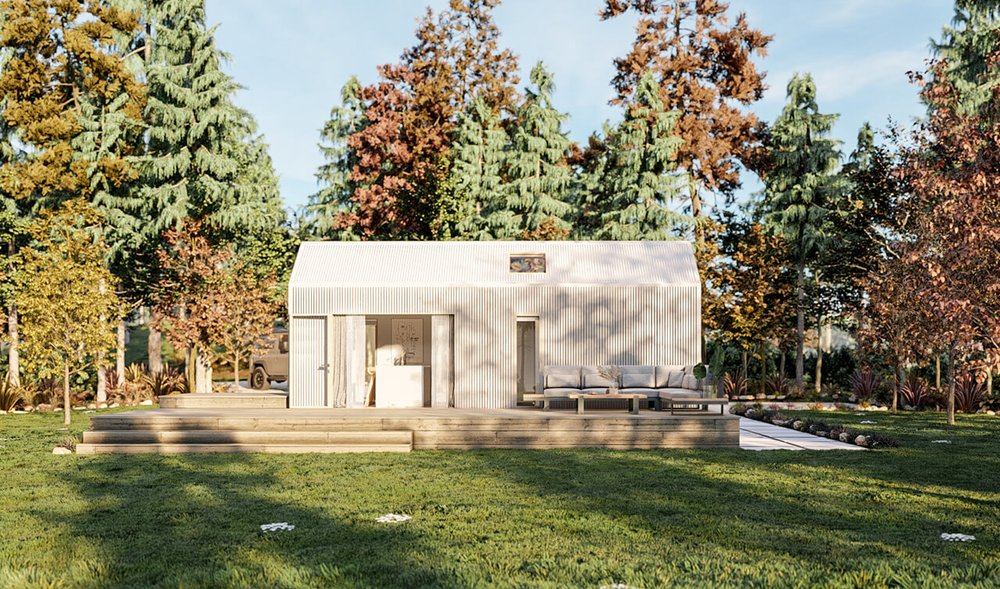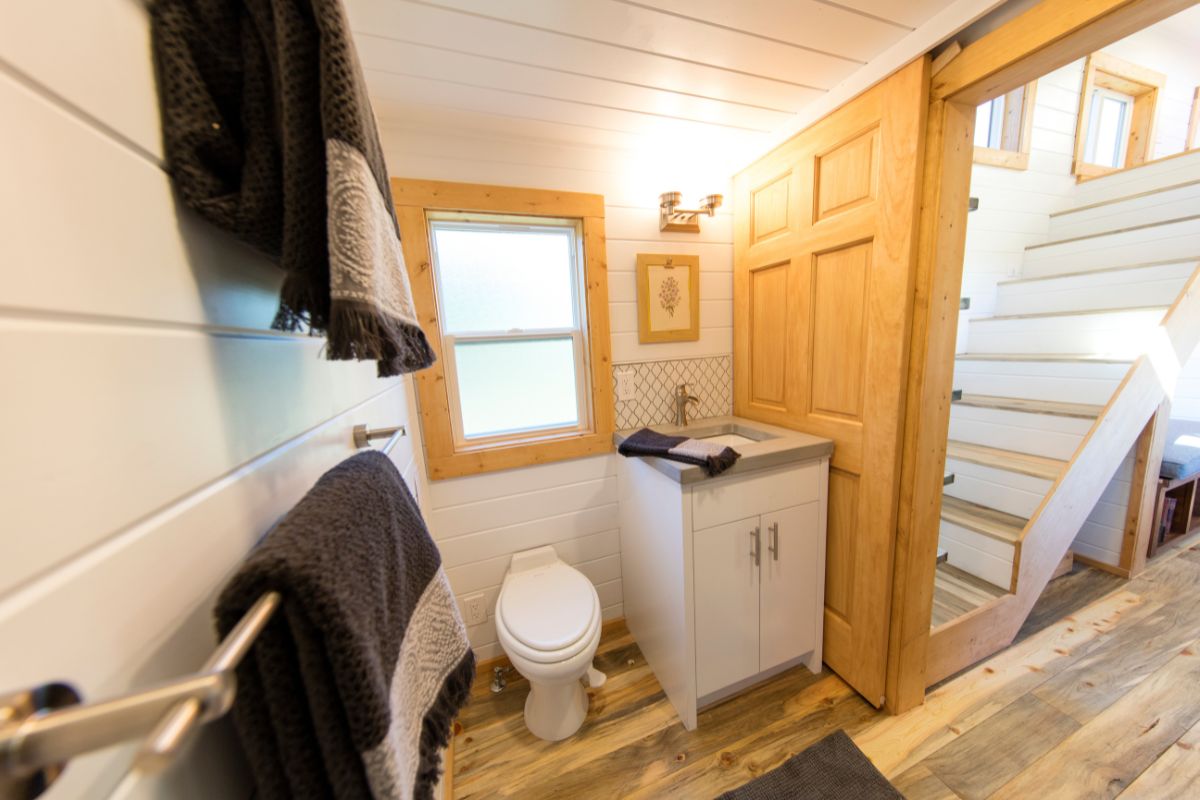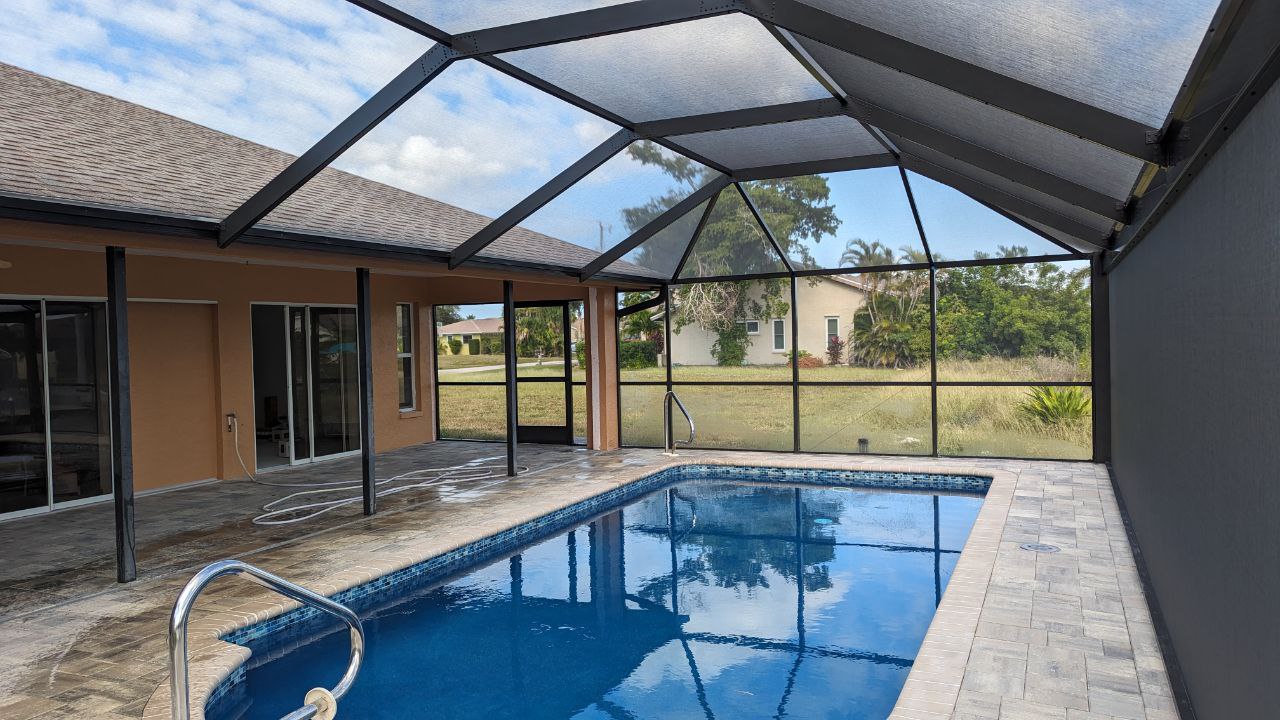To keep your tiny house cool in hot climates, strategically place windows and vents to maximize cross-ventilation and consider the local wind patterns. Use reflective materials for roofs and windows to minimize heat gain. Prioritize high R-value insulation to create an airtight envelope. Install shading solutions like awnings and plant deciduous trees for seasonal benefits.
Choose energy-efficient appliances, including those with high Energy Star ratings. Smart landscaping and nighttime cooling techniques enhance comfort further. Discover more strategies ahead.
Key Takeaways
-
Optimize cross-ventilation by strategically placing windows on opposite walls for enhanced airflow.
-
Apply reflective roof coatings and window films to reduce heat absorption and gain.
-
Invest in high R-value insulation materials to ensure superior thermal resistance and airtightness.
-
Implement shading solutions like awnings and plant deciduous trees for seasonal sunlight control.
-
Choose energy-efficient appliances with high Energy Star ratings to minimize power consumption.
Optimize Natural Ventilation
When optimizing natural ventilation in a tiny house, first consider the strategic placement of windows and vents to facilitate cross-ventilation. Positioning windows on opposite walls allows for airflow across the interior, capitalizing on the natural movement of air.
Ascertain vents are high and low, promoting a chimney effect that draws cooler air in while expelling warm air upwards. Analyze local wind patterns to orient openings effectively, maximizing breeze entry. Opt for operable windows with adjustable louvers to control airflow direction and volume. Incorporate ceiling fans to enhance air circulation without consuming excessive energy.
Evaluate the thermal mass of interior materials; they can moderate temperature fluctuations. By meticulously planning airflow pathways, you’ll achieve an efficient, naturally ventilated environment.
Utilize Reflective Materials

After establishing an efficient natural ventilation system, it's important to contemplate the role of reflective materials in maintaining a cooler environment in your tiny house. Reflective materials, such as specialized paints, films, or roof coatings, can considerably reduce heat absorption.
By applying a reflective roof coating, you can reflect solar radiation away from your tiny house, decreasing roof temperatures and, consequently, indoor heat levels. Window films with reflective properties also minimize heat gain by bouncing sunlight back outside. Analyze and select materials with high solar reflectance and thermal emittance ratings for maximum efficiency.
Position reflective surfaces strategically on areas most exposed to direct sunlight, ensuring they intercept and redirect solar energy effectively. This proactive approach enhances your tiny house's thermal comfort while optimizing energy efficiency.
Invest in Insulation
To achieve ideal thermal comfort in your tiny house, investing in high-quality insulation is crucial. Start by selecting materials with high R-values, which measure thermal resistance. Opt for spray foam or rigid foam panels, as they offer superior insulation per inch and effectively minimize heat transfer. Focus on insulating walls, roof, and flooring to create an airtight envelope, reducing thermal bridging and air leakage.
Don’t overlook the importance of sealing gaps around windows, doors, and electrical outlets. Use weatherstripping and caulking to prevent warm air infiltration. Additionally, consider installing a vapor barrier to control moisture build-up, which can degrade insulation performance. Regularly inspect and maintain your insulation to guarantee it remains effective, ultimately enhancing energy efficiency and comfort in hot climates.

Incorporate Shading Solutions
Why is shading an essential component of your tiny house cooling strategy? Shading reduces solar heat gain, a critical factor in maintaining a comfortable indoor environment. You can implement strategic solutions like awnings, overhangs, and pergolas to block direct sunlight. Install exterior shades or shutters, which can be adjusted to filter light and heat without obstructing airflow.
Opt for deciduous trees or tall shrubs around your tiny house, providing shade during summer while allowing sunlight during winter. Consider reflective surfaces or materials with high albedo for roofing and external walls to deflect sunlight effectively. Employing these shading techniques minimizes reliance on artificial cooling, thereby reducing energy consumption. By incorporating these solutions, you'll enhance thermal comfort while optimizing energy efficiency.
Choose Energy-Efficient Appliances
While optimizing your tiny house for energy efficiency, selecting the right appliances plays a pivotal role in reducing overall power consumption.
Focus on appliances with high Energy Star ratings, as they use less energy without sacrificing performance. In hot climates, efficient air conditioners are essential. Look for units with high SEER (Seasonal Energy Efficiency Ratio) ratings, ensuring they cool effectively while minimizing energy use. Additionally, consider inverter technology, which adjusts compressor speed to maintain consistent temperatures and reduce electricity usage.
Prioritize LED lighting over incandescent bulbs, as LEDs consume considerably less energy and generate less heat. When selecting kitchen appliances, opt for induction cooktops and convection ovens, both of which offer superior energy efficiency compared to traditional electric counterparts.
Implement Smart Landscaping

Smart landscaping is an essential strategy for naturally cooling your tiny house and enhancing energy efficiency. Start by planting deciduous trees on the southern and western sides to provide shade during summer, reducing solar heat gain. In winter, their bare branches allow sunlight to warm your home.
Utilize groundcover plants to minimize heat absorption and reduce soil temperature. Strategic placement of shrubs can channel cooling breezes toward your home while blocking hot winds. Install a green roof to further insulate against heat. Use reflective mulch around your plants to decrease ground temperature.
Grouping plants with similar water needs conserves moisture, optimizing irrigation efficiency. Incorporate permeable pathways that absorb less heat than concrete. These methods contribute greatly to maintaining a cooler interior environment.
Adopt Nighttime Cooling Techniques
To maximize cooling efficiency in your tiny house, you should adopt strategic nighttime cooling techniques. First, utilize cross-ventilation by opening windows on opposite sides of your house to create an air pathway. This method expels warm air while inviting cooler night breezes inside.
Confirm all internal doors are open to facilitate unrestricted airflow. Next, employ thermal mass materials such as concrete or stone floors, which absorb heat during the day and release it at night, stabilizing indoor temperatures.
Consider using a whole-house fan to enhance air movement. Set it to run for a few hours after sunset to effectively replace stale, warm air with cooler outdoor air. Finally, close windows before sunrise to retain the cool air captured overnight.
Conclusion
By optimizing natural ventilation and utilizing reflective materials, you can greatly reduce heat absorption in your tiny house. Invest in high-quality insulation to maintain a stable indoor temperature and incorporate shading solutions like awnings or blinds.
Choose energy-efficient appliances to minimize heat output, and implement smart landscaping to create a cooler microclimate. Finally, adopt nighttime cooling techniques to capitalize on cooler evening air. These strategies collectively enhance comfort and efficiency in hot climates, ensuring a sustainable living environment.






Share: